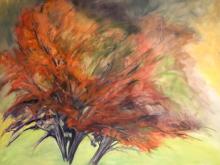Submitted by ARASAllison on
 Art is dream realized, and this is why we value it—as an earnest that our dreams might be realized in life ~ Wendy Steiner
Art is dream realized, and this is why we value it—as an earnest that our dreams might be realized in life ~ Wendy Steiner
Before any talk, my First Nations friends and colleagues Dave and Imelda Perley taught me to acknowledge the land and the first peoples who occupied it wherever we are gathered. In Siracusa, it is the Siculi Italici. In New Brunswick, eastern Canada (Fig. 2) where I live it is the Wolastoqewiyik (pronounced, Woo-luss-ta-goog), the place of the beautiful and bountiful river of the Mig’maw and Maliseet peoples. Specifically Keswick Ridge (Fig. 3) the land that greets me each morning and sees me safely to sleep at night—companion to my life and work for nearly 25 years.
Like the brick and mortar that were so fundamental to my grandfather’s trade, in Beautiful Dreamer: Landscape and Memory, images and words, canvas and computer are my materials and tools. Beautiful Dreamer is a privileged site of old and new construction, of continual renovations characterized by layer upon layer of active waiting, breathing through thresholds, imagining and re-imagining possible worlds. It is where I labor, in gratitude, to understand and heal the psychic havoc wrought by early loss, domestic violence and Kantian aesthetics.
Reconstructing or mapping physical artistic processes and psychological experiences—slivers of insight, fragments of living an examined life—can coalesce in myriad ways. For me it is a matter of submitting myself again and again to the intrigue of a kind of hermeneutic hall of mirrors where ideas bounce off brush strokes and swirls of reading paint text. There, divine light illuminates memory and faith stares down doubt. In the air beautiful voices, long overshadowed by fear and anxiety, sing their songs of possibility, while others caution not to mistake pointing to the moon for the moon (Fig. 4).
Read Beautiful Dreamer: Landscape and Memory in its entirety.